
Waterstradt Home Page
Shania page - a Waterstraat cousin
Waterstraat History Books
Storys
Waterstradt Women
Zany Items
Waterstradt Immigration and Homesteading
More Waterstraat History
Waterstradt Land of Old Germany
Employment and schooling
Contact Page
Waterstraat Holidays
Favorite Links
Personal Page and Miscellaneous Items
Newspaper Items
Historian's Page
Guest Book Page
|

Waterstrat Family History in early Nebraska
Waterstradt Women
The Life of a Waterstraat Farm Woman
Whether it was in old Germany, or on the early homesteads in Garfield County, Nebraska, everyday life was little changed for the early Waterstraat women at the turn of the century.
The women were farm workers whose jobs differed only slightly from those of the men. The women did heavy manual labor, working just as hard as the men. Their usual work day on the farm was 12 to 14 hours per day, and in the harvest season, often 17 to 18 hours per day.
Women did the turnip and potato planting and harvesting, chopping work, sheaf binding, and corn picking as well as other tasks. The women who had to work the hardest were the peasants who were day laborers or who lived on the small and middle sized farms. This also included the daughters,who remained at home in their parents' houses as hard working unpaid farm servants.
The farm servants, including female farm servants, did all kinds of work. They were responsible for cutting and reaping, shoveling up the dung and loading it, cleaning out the stables, milking, feeding and caring for the animals,and leading the team. The only stable job they didn't have was taking care of the horses. Any new technology, although little technology came to Mecklenburg on the small farms, usually benefited only the men.
The women did the work of the house and cared for the stables. They were also responsible for the care and education of the children, the care and planting of the garden, the feeding and care of the animals, the washing of the laundry and the preparation of the meals. They had to help in the fields, particularly during harvest. When the hard physical work of the day was done, the women still had to take care of the household items and clothes for their families. It was not surprising, therefore, that the women often fell asleep late at night while doing their mending. During the end of the 19th century and the beginning of the 20th century in Mecklenburg, women had no leisure time.
The Wash (Die Wäsche)
The oldest form of laundry washing used a barrel which sat upright on a three-legged stand. The laundry was placed in the barrel. A sheet was placed over the top of the barrel and two buckets full of sieved beech ash were poured onto the sheet. Then water was poured over the ash. First cold water, then warm water, and at last boiling water. After the laundry had set some time in the caustic solution to give it time to work, the solution was discharged from a hole near the bottom of the barrel. A wood stick with a bent end
was used as a paddle to prevent the laundry from clogging the hole as the solution ran off. The runoff was collected, heated again, and poured over the laundry another time. This continued until all the ash was leached out.
This process lasted 12 to 24 hours. The laundry was then rinsed as much as possible with flowing water, wrung out by hand, and laid in the sun to bleach or hung on a line to dry.
When other materials besides linen began to be be used for clothing, the washing methods changed. A wash boiler for cooking the laundry was set up in the kitchen. The laundry was placed in the upper part or tub of the boiler. The women then carried buckets of water from the well or the pump to fill the tub. Rain water, soft water, was also collected. A fire was built in the firebox under the tub and the laundry was cooked and stirred with a paddle. After the cooking, the women rubbed the laundry on a wash board with a hot soap solution. Next it was rinsed in a tub, wrung out by hand, and then put in the sun to bleach or hung on the line to dry.
After 1900 some farms got swing washers which saved the rubbing on the washboard and had a mechanism for wringing out the clothes. These mechanisms still had to be cranked by hand,however. Also around this time the pump was brought into the house so water did not have to be drawn from the well.
Because it was such a time consuming process, the laundry was only done once every 4 to 6 weeks.
Work in the Garden (Arbeit im Garten)
The garden played an important role as a food source for the family. Both marriage partners dug up the garden, but the planting and caring of the garden was the responsibility of the woman.
The garden had patches or plots in a geometric pattern. Both vegetables and fruit were planted. Some of the vegetables planted were beans, peas, turnips, and potatoes. Around 1900 cucumbers, carrots and lettuce were added. Cabbage was the most important and the most used vegetable, particularly head cabbage. Seasoning herbs planted included dill, parsley, thyme, mint and sage.
Around 1860 the farmers' wives began planting flowers as well. They cultivated flowers which were undemanding and did not require much work.
Fruit from the garden was served for fresh consumption and also dried and then stored to be used in future baking. Vegetables were served fresh and also dried and packed in salt for later use.
Cooking and Baking (Kochen und Backen)
Preparing the meals was the work of the women, both with the farmers' wives and with the daily wage earners'wives. The meals were heavy, rich, and full of calories. This was appropriate food because of the hard physical labor that was required to maintain a farm.
In the 1800's the women began fixing a one-dish meal on working days. The preparation of these cooked together dishes took less time and that left more time for other household tasks. These one dish meals were usually made from cabbage with a bacon or ham bone or legumes with dried fruit and salted meat. Other popular dishes were baking pears and dumplings, sweet-sour dumplings, thick peas and pea soup, green cabbage with roasting potatoes and smoked pigs head, grits and blood sausage, potato pancakes, or cooked smoked pig ribs and vegetables.
In the 1900's other dishes added to the meals were dry potatoes with sauce and bacon or ham, cabbage in any form, in the summer bacon, in the winter salted meat, head cheese, barley and potatoes with salted meat, and apple and potato dumplings. On special occasions a pig roast was a favorite.
With many of the meals there was only a few small specks of meat in the soup or dish. It depended upon the economic status of the farmer. Until 1900 it was usual to eat from a common dish. Later everyone had his own plate.
It was the women's job to prepare the bread dough, watch it set, knead it, and form it. Heating up the furnace or bread oven was the man's job.
If a family, such as a day laborer's family, did not have their own bread oven, they had to bake their bread in a community baking oven. The schedule for the heating and the sequence for the use of this oven was determined by the property owner. The heating of the oven usually began at 3 o'clock in the morning so that by 6 o'clock the women could begin inserting their bread. In order to identify what bread belonged to which family, the women marked their loaves with letters or characters.
Until the end of the 1800's, they baked hard rye or black bread for normal consumption, fine rye bread for Sunday and holidays. They also made wheat bread and white bread for special occasions. These were brushed with milk and contained raisins or currants.
In the 1900's the rural households ate hard crusted rye bread in quantities. This was thought to provide strength and satisfied the hearty appetites. When they had wheat bread, they ate it in small quantities and in dainty bites. Around 1900 they began to have cake, but only on holidays. It was prepared with butter, eggs, raisins, sugar and cinnamon, and cooked on a dish or in a box form. Plate cakes and pot cakes were very similar. The baking was done at different intervals, depending upon the work load.
Meal Schedule on the Farm Around 1860
Morning Bread (breakfast) was served at 5 o'clock in the morning before work began. It was usually bacon with cooked potatoes. The women prepared it the evening before and then cooked it in the morning. In some areas they served milk soup. In southern Mecklenburg it was the custom to serve chicory coffee with buttered bread.
Small Lunch was served at 8 o'clock and consisted of bread and bacon. It was also customary to serve a brewed beer.
The Lunch was served at 12 o'clock. This was usually the largest meal. It consisted of a mixed dish (one dish) like those mentioned above. Family members often also got a piece of bacon or ham, but these were not served to the hired help.
Evening Bread was served at 4 o'clock. In the summer it was served in the fields. It consisted of bread and butter or bacon or ham. Night Food was served at 8 o'clock. A potato dish was the custom and it was
served without meat.
Educating the Children (Zur Kindererziehung)
Little consideration was given to the health of the women, even during pregnancy. The peasant women were at a disadvantage compared to the wives of wealthy farmers. The wealthy farmer's wife spent three months in the house before the birth, called quiet time, and at least 14 days after the birth recuperating before she came out in public and returned to her obligations. The peasant woman worked right up until the birth. Sometimes babies were even born in the fields. The woman returned to work 6 days after the birth of her child. This was because there was so much work to do, there was no one else to do the work, or because the wages were needed for the family.
As a result of the hard physical work of women during pregnancy as well as the lack of medical help and the lack of cleanliness, many women and newborn infants died during childbirth or shortly thereafter. When a child was born, particularly the first born, a boy was valued much more than a girl.
The women fed the child themselves by breast feeding often up to one year of age. The care of the baby was integrated with the routine daily work. If a woman went back to work in the fields, she left the baby with an older child or the grandmother. Frequently the mother had to take the child with her to the field if there was no other person to watch out for it.
The children learned to eat the food of the adults at a very early age. This included the drinking of alcoholic beverages. There was no time for special food and special attention for small children. The child's care could not interfere with the work of the women or that work would get behind.
The education and care of the children was the responsibility of the woman. At about 3 years of age, that education began. Generally the children were educated in modesty, manners, and reverence for older people and parents. The woman made sure the children showed proper respect for their parents, but did not get too close to them. The children had to learn to fend for themselves.
The children attended school from ages 6 to 14. They missed school during the summer half of the year in order to help parents in the fields and at home. The children were trained in farm work at an early age. The boys began around age 8 to tend the geese. As they got older they were trained to guard the sheep and cows. The girls first learned to care for the poultry. As they got older, they learned to feed and milk the cows. The girls were also expected to watch the younger children and often had to stay home from school in order to do that. By the time the boys and girls were 15 years of age, they were expected to do the work of an adult. They either worked with their parents on the farm or were hired out as maids or farm workers for wages.
Body cleanliness left much to be desired, particularly in the small rural household. Cleanliness was more or less limited to a daily washing of the face and hands. Soap was rarely used. Teeth cleaning was not usual in most families. During the warmer months an infrequent dip in the river or creek or an occasional bath in a tub sufficed. This was true for both children and adults.
Helping With The Harvest (Mithilfe bei der Ernte)
All of the members of the family and the hired help participated in the harvest. Beginning in the 1850's, even in the manor house, all of the inside work was stopped and the domestic help worked in the fields during peak times. Women took over much of the seasonal work.
Digging up and collecting the potatoes was the work of the women and children. The women also were responsible for making the potato mounds and planting the plants. Women were involved in the turnip fields from spring to fall as they both planted the turnips and harvested them.
Another job of the women was the binding of the grain. For this work they wore a white linen apron and either linen or cotton clothes with long sleeves to protect their arms from the hard stems. A binder walked behind each mower. Often a married couple worked together.
The women also helped with the sheaving or bundling of the grain. The special job of some women was loading the harvest carts. They also loaded the hay carts during the hay harvest.
The women participated in the winter threshing also, flailing the stocks to separate the grain from the chaff. When the threshing machine took over that job, it made the work easier, but they still had to rake the chaff out from under the machine. All of this had to be done even in unfavorable weather. It was regarded as arduous and unpleasant work.
Butchering the Pigs (Schweineschlachtung)
Slaughtering time meant several days of increased work, but everyone looked forward to it as a kind of celebration since it replenished the food supply and there was plenty of fresh meat for the coming meals. Slaughtering was done in the winter, usually before Christmas and again in February. Normally a butcher was hired, but sometimes a skillful day laborer or craftsman from the village did the slaughtering and the butchering. The job of the women during the slaughter was mostly to keep the blood stirred and fresh,
since the blood was needed for sausage.
After the slaughtering, the pig was covered with boiling water, scraped clean, and divided into two long halves. These halves were then hung up to cool in the winter air before the butcher divided them further. After the butcher cut up the pig, it was divided into meat for bacon, ham and sausage. Some of the parts, such as the feet, were put into pickling brine to make supplies for the year.
The men chopped the meat for sausage with a cleaver and pounded it or later put it through a meat grinder when this was introduced as an innovation. The women then took over. They ground the meat to a finer consistency, seasoned it to taste, and kneaded all
the ingredients together. Then various parts of the pig were added depending upon the types of sausage being made. Cooking of any ingredients was done as needed.
The types of sausage prepared for smoking and storage for the year were Mettwurst (bologna sausage), blood sausage, liver sausage and lung sausage. After the sausage was made, they stuffed the meat into casings made from the intestines. The men helped with the stuffing. For fresh consumption, they saved out some blood sausage.
The bacon, ham, and pig's head were placed in brine. Later they were smoked along with the sausages. Smoking took two to three weeks. This work was all done by the women. When finished, the hams, bacon and sausage were hung from the ceiling in a storage area (often the rafters of the barn) to be used as needed.
Feeding and Caring for Animals
The care and feeding of the poultry was always women's work. On larger farms sometimes one particular domestic servant was in charge of the chickens. On smaller farms the women took care of the chickens as part of their work. In the summer the chickens could scratch and find most of their food for themselves. In the winter they had to be fed with grain and potatoes. The chicken house was usually attached to the farmhouse and they nested there. The sitting nests were put near the warm wall of the house during the winter and put in a cooler area during the summer. There was a superstition that if the woman threw the chicken's first egg on the roof, the hen would lay many eggs from then on. Geese had special meaning to Waterstraats. They received special care. A herd of geese was usually driven from after Easter to the end of July on a fallow field and after that over the grain stubble. A boy or girl was assigned to guard the geese. The young geese were given dandelion greens with bran, pellets, or torn up bread to eat. The killing and plucking of geese was the woman's work. She had to pick out the feathers that were the best for bed fillings and prepare them to be used. Other feathers were used for quilts and pillows. The breasts of the geese were smoked and eaten and the livers were used as well.
Most families did not like to keep ducks because they were hard to feed. They ate too much. In the farm economy, they were more intended for sales to those living in the city and were not kept for the farmer's own consumption.
The feeding and care of the pigs was always the work of the women. The women used cooked potatoes or potato peelings as a base for the food. Over this was poured all the kitchen food wastes and then water or skimmed milk. This mixed bucket of slop was fed to the pigs twice a day, in the morning and in the evening. Some women fed their pigs three times a day to fatten them up.
The women did all the milking of the cows on the small farm. They were in charge of feeding the cows as well. When a new calf was born, some women left the calf with the mother for 4 to 6 weeks. Most removed the calf very soon to a separate stall, however, and fed it for the first 6 months with sweet or sour milk. According to superstition, the newborn calf was covered with a mixture of dill and salt to protect it against diseases.
Other Tasks
There are many other tasks that were part of the women's work that are not even mentioned here. Some of the ones I thought of were making candles, making soap, sewing clothes, cleaning the house. I'm sure you will be able to think of others.
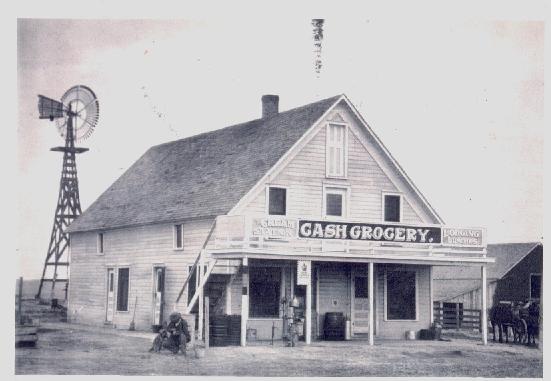
Waterstraat women loved this place, the hall upstairs was the scene of many dances
|
|

Paula Poundstone, who is a world famous female comedian, and regularly appears on several tv shows, including her own, walking into court, July, 2001.
|
|

Gina's grandfather, Otto, 1899
|
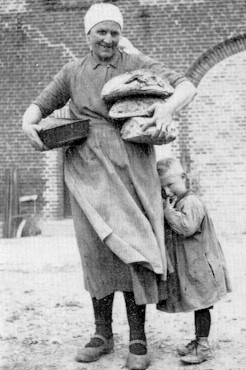
Fresh Waterstraat bread
|
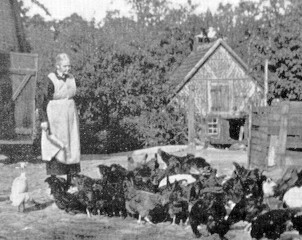
Feeding the chickens
|
|
|
|
|
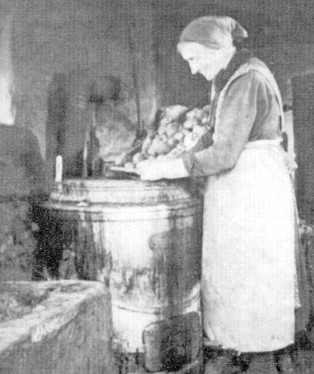 Wash day
Wash day
|
|
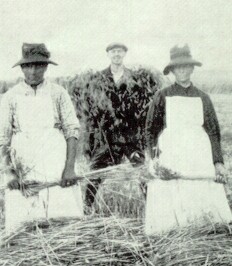 Gathering wheat on the Nebraska plain
Gathering wheat on the Nebraska plain
|
|
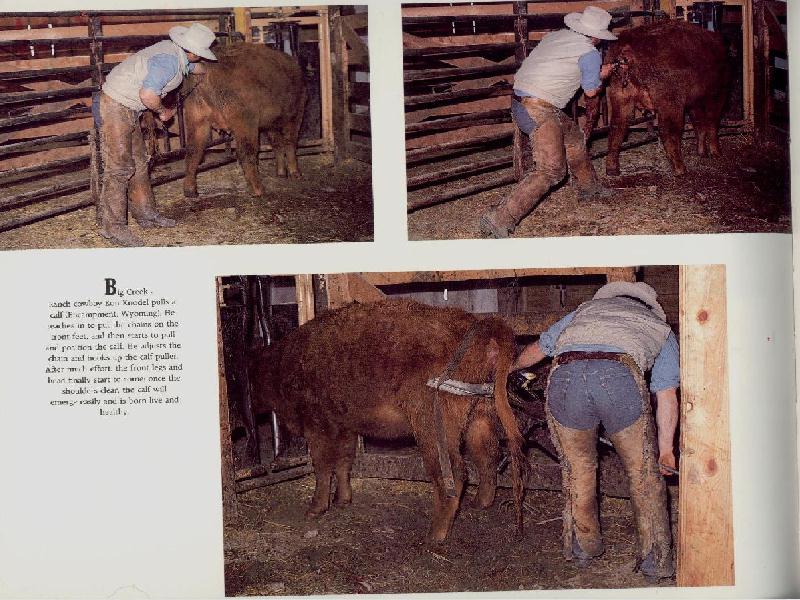 This is calf-pulling, and Sandy from modern day Nebraska, is reputed to be an expert "calf puller"
This is calf-pulling, and Sandy from modern day Nebraska, is reputed to be an expert "calf puller"
|
|
|
Gina's mother
|
|
|
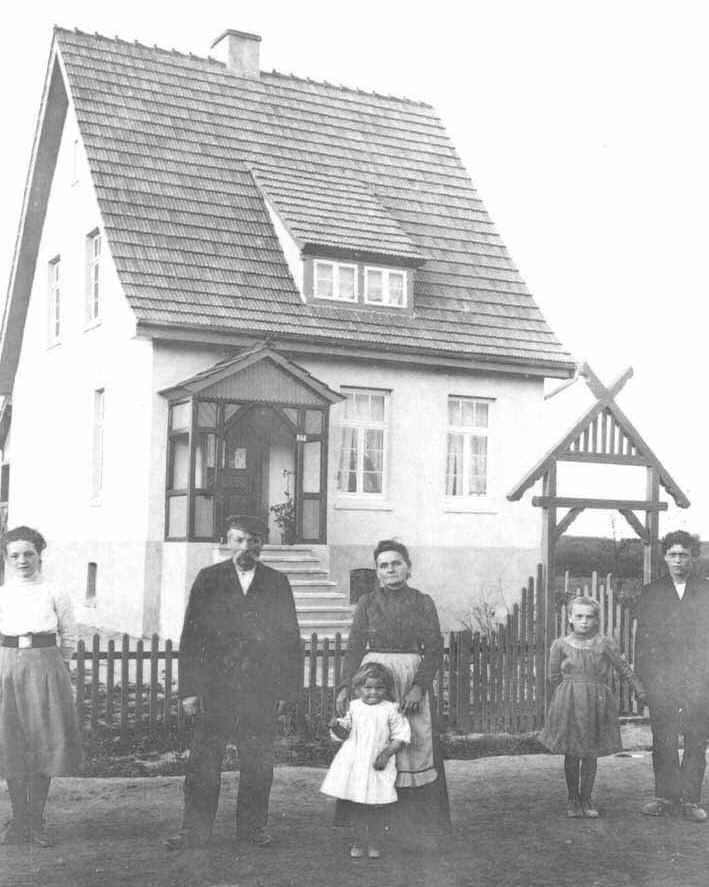 Gina's grandparents, Adolph and Caroline, 1910
Gina's grandparents, Adolph and Caroline, 1910
|
|
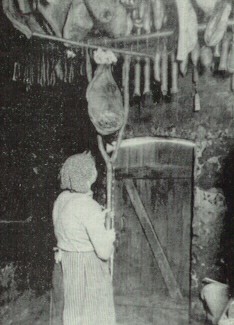 Waterstraat sausage
Waterstraat sausage
|
|
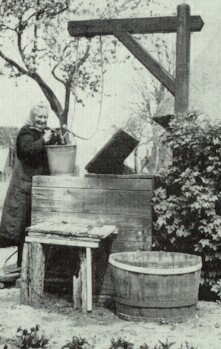 Drawing water from the Waterstraat well
Drawing water from the Waterstraat well
|
|
 Lauren from Iowa
Lauren from Iowa
|
|
 Debbie and Tom Waterstraat from Las Vegas, Nevada, Tom is now a civilian contractor at Nellis Air Force base.
Debbie and Tom Waterstraat from Las Vegas, Nevada, Tom is now a civilian contractor at Nellis Air Force base.
|
|
 An really old photo of Debbie and Tom Waterstraat back when Tom was in the air force.
An really old photo of Debbie and Tom Waterstraat back when Tom was in the air force.
|
|
